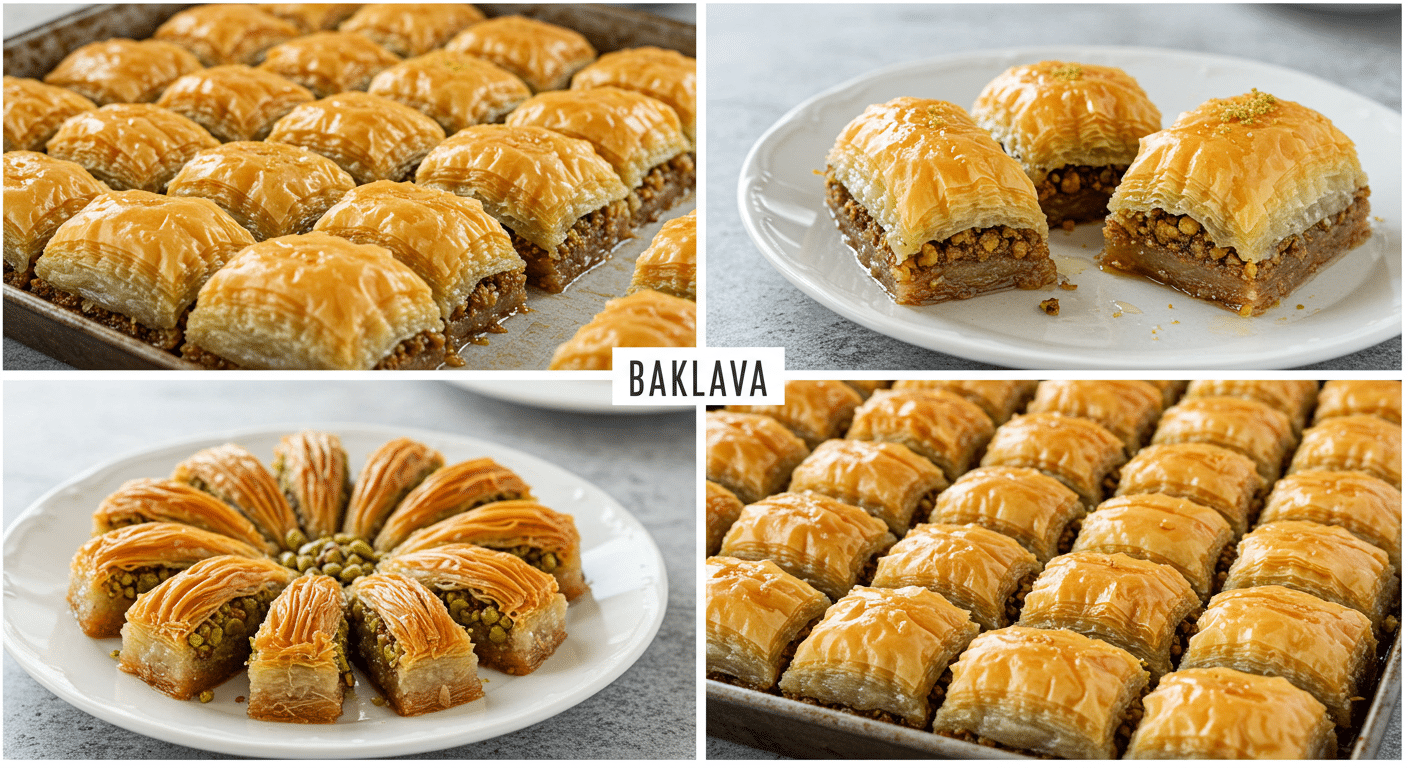When it comes to indulging your sweet tooth, Turkish cuisine offers a treasure trove of rich, flavorful desserts that are steeped in centuries of history and tradition. From syrup-soaked pastries to creamy puddings, Turkish food desserts blend Middle Eastern, Central Asian, and Mediterranean influences to create truly unique and memorable sweets.
In this article, you’ll discover some of the most popular Turkish desserts, the signature sweet treat of Turkey, and a few lesser-known delights that are just as delicious. Whether you’re planning to explore Turkish cuisine or recreate these treats at home, you’re in for a mouthwatering experience! (Turkish Food Desserts)
Table of Contents
Table of Contents
What Are Popular Turkish food Desserts?
Turkey is known for its incredible variety of desserts. Some of the most popular Turkish food desserts include:
- Baklava – flaky pastry layers filled with nuts and soaked in syrup
- Künefe – cheese-filled pastry soaked in syrup and served hot
- Lokum (Turkish Delight) – chewy, flavored candy dusted with powdered sugar
- Sütlaç (Rice Pudding) – oven-baked creamy rice dessert
- Tavuk Göğsü – a milk pudding made with shredded chicken breast
- Aşure (Noah’s Pudding) – a porridge of grains, legumes, fruits, and nuts
Let’s explore each one in detail. (Turkish Food Desserts)
1. Baklava
Possibly the most iconic of all Turkish food desserts, baklava features delicate layers of filo pastry filled with chopped pistachios or walnuts, drenched in a sweet syrup made from sugar, water, and lemon juice. Originating from the Ottoman palaces, baklava is often served on special occasions and holidays. (Turkish Food Desserts)
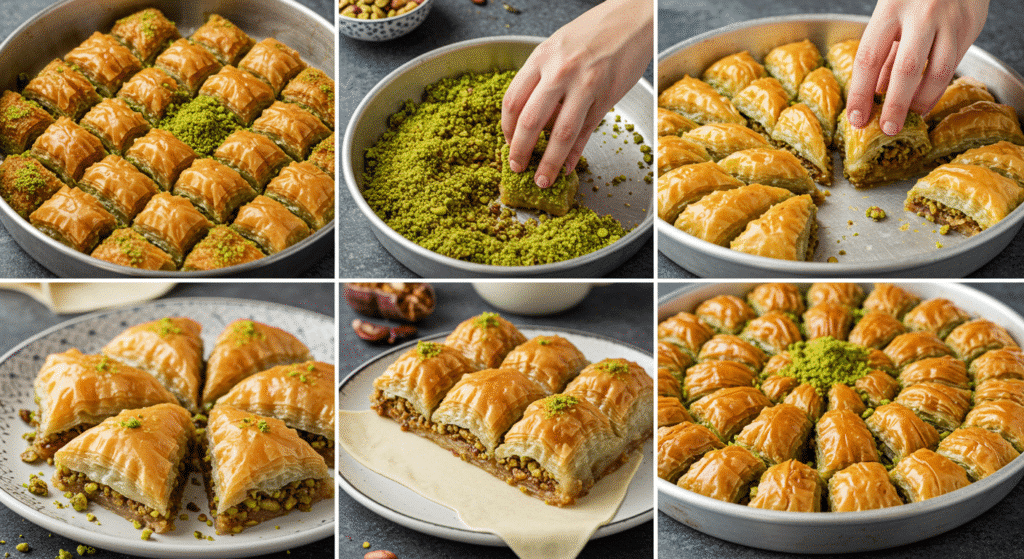
Classic Turkish Baklava Recipe
Prep Time: 30 minutes
Cook Time: 45 minutes
Total Time: 1 hour 15 minutes
Servings: 24 pieces
Keyword: Turkish food desserts
🧺 Ingredients
For the Baklava:
- 1 package (16 oz) phyllo dough, thawed
- 2 cups finely chopped pistachios or walnuts
- 1 cup unsalted butter, melted (about 2 sticks)
For the Syrup:
- 1 ½ cups sugar
- 1 cup water
- ½ cup honey
- 1 tbsp lemon juice
- 1 tsp rose water or a few drops of vanilla (optional)
👩🍳 Instructions
Step 1: Prepare the Syrup
- In a saucepan, combine sugar, water, honey, and lemon juice.
- Bring to a boil, then reduce heat and simmer for 10 minutes.
- Add rose water (optional). Let it cool completely. (Turkish Food Desserts)
🔁 Tip: Always pour cooled syrup over hot baklava—this keeps it crisp.
Step 2: Assemble the Baklava
- Preheat oven to 350°F (175°C).
- Brush the bottom of a 9×13-inch baking dish with melted butter.
- Layer 8–10 sheets of phyllo, brushing each with butter.
- Sprinkle about ½ cup of nuts over the layered phyllo.
- Continue layering: 4 sheets of phyllo + butter → nuts, repeating until nuts are used.
- Finish with 8–10 sheets of phyllo, buttered between each.
- Cut into diamonds or squares using a sharp knife. (Turkish Food Desserts)
Step 3: Bake
- Bake for 45–50 minutes, or until golden and crisp on top.
Step 4: Add the Syrup
- As soon as it comes out of the oven, pour the cooled syrup evenly over the hot baklava.
- Let it sit at room temperature for 4–6 hours to soak and set before serving.
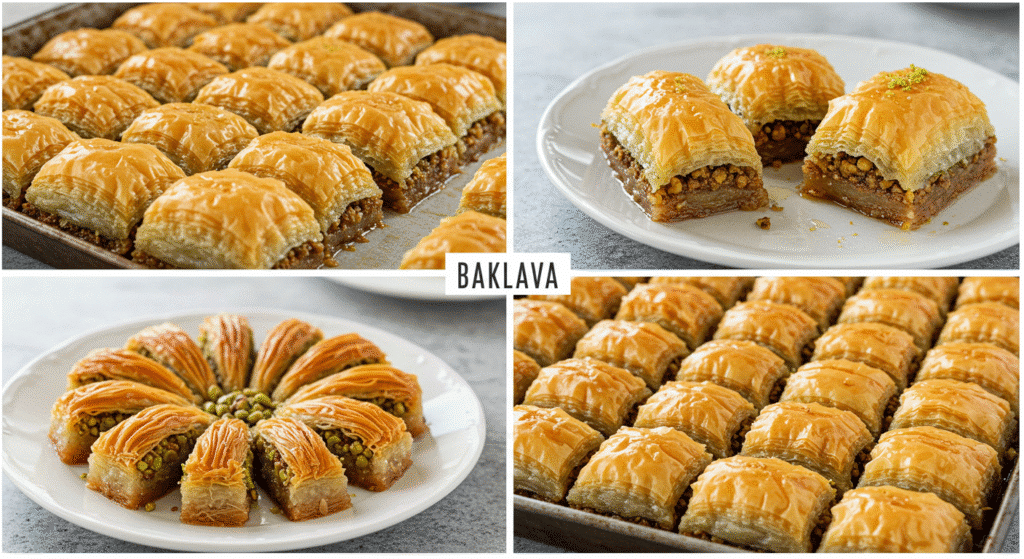
🌟 Serving Tips
- Garnish with chopped pistachios or a dusting of powdered sugar.
- Serve with Turkish tea or strong coffee.
2. Künefe
This indulgent dessert comes from the southeastern region of Turkey. Künefe is made with shredded kataifi dough layered with mild cheese, baked until golden, and soaked in sweet syrup. It’s served warm and often topped with pistachios. The contrast between the crisp pastry and gooey cheese makes it a true favorite. (Turkish Food Desserts)
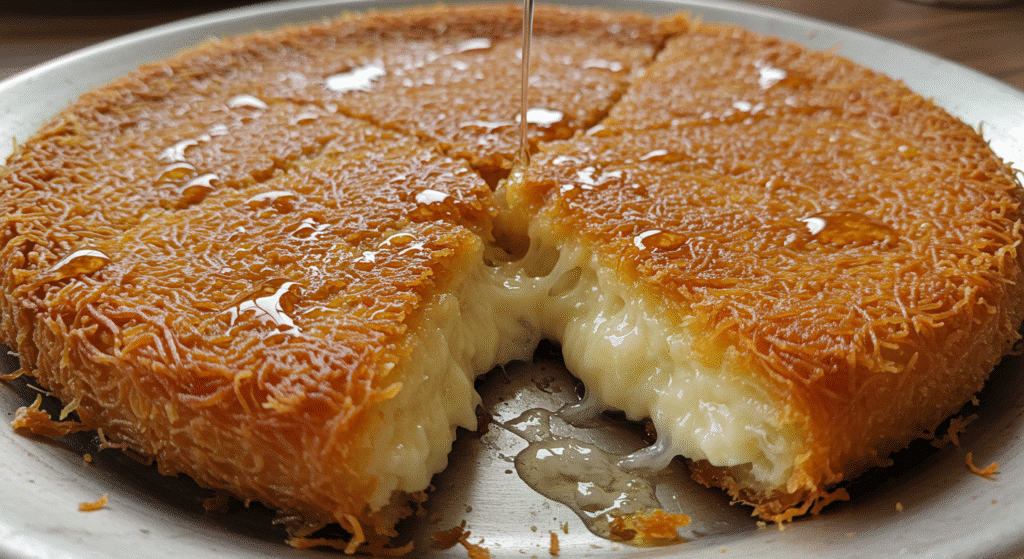
Course Dessert
Cuisine Turkish
Keyword cheese, kadayif, pastries, pastry, Turkey, Turkish
Prep Time 30minutes minutes
Cook Time 50minutes minutes
Total Time 1 hour 20minutes
Servings 4 -6 Servings
Ingredients
Syrup:
- 2 cups (400 grams) granulated sugar
- 2 cups (470 milliliters) water
- 1 tablespoon (15 milliliters) freshly squeezed lemon juice
For greasing the pan:
- 4 tablespoons (60 grams) unsalted butter softened at room temperature
- 1 tablespoon (15 milliliters) grape molasses
Pastry:
- 1 pound (454 grams) Kadayıf (kadaifi/kataifi), shredded phyllo
- 1 cup (227 grams) unsalted butter melted
- 10 ounces (283 grams) unsalted and stringy Turkish cheese or Mozzarella
Garnish:
- Finely ground pistachios for topping
Instructions
To make the syrup:
- In a medium pot, bring the sugar and water to a boil. Reduce to a simmer and cook until the sugar is dissolved and the liquid is starting to thicken slightly, about 10 minutes.
- Stir in the lemon juice and simmer for another 1-2 minutes to blend the flavors.
- Remove from heat and allow to cool to room temperature.
To grease the pans:
- In a small bowl, mix together the softened butter and grape molasses.
- Generously grease 4-6 individual or one large stove-safe pans with half the butter (they will be greased again before flipping the pastries).
To arrange the pastry:
- Roughly chop the Kadayıf into 1 inch (2.5 centimeter) pieces and place in a large bowl.
- Pour the melted butter over the chopped Kadayıf and toss to thoroughly coat.
- Press a layer of the coated Kadayıf across the bottom and sides of the prepared pans.
- Cover each layer of pastry with a layer of the cheese, leaving about a 1/2 inch (1.25 centimeter) border around the edges.
- Cover the cheese with another layer of the Kadayif. Press down to completely enclose the layer of cheese, especially around the sides.
- Place the pan over medium low heat. Cook until the bottom is golden, adjusting the heat between medium and low as needed, for about 6 minutes.
- Carefully flip the pastry onto a plate.
- Grease the pan again with the grape molasses butter mixture and place the pastry back into the pan, golden side up.
- Place the pan back over medium low heat and cook until golden on the bottom, another 4-5 minutes.
- Remove the pan from heat and immediately pour the desired amount of cooled syrup over the pastry to soak.
- Serve the Künefe hot while the cheese is still melted and stretchy.
3. Lokum (Turkish Delight)
A famous Turkish treat that’s been enjoyed for centuries. Lokum comes in a variety of flavors like rose, lemon, and pomegranate, and often contains nuts like pistachios or hazelnuts. It has a soft, jelly-like texture and is typically served with Turkish coffee. (Turkish Food Desserts)
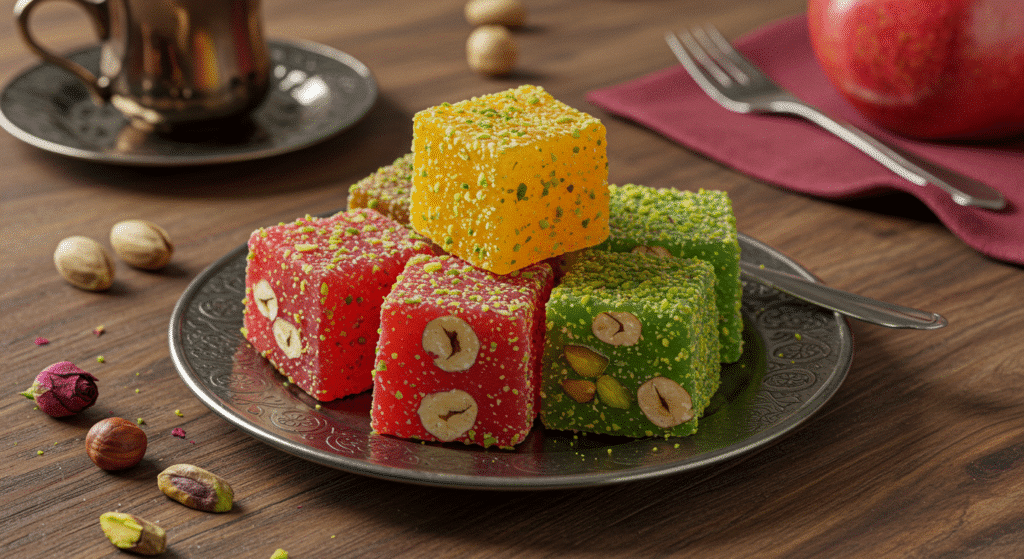
Ingredients
For dusting and coating:
- ▢3 1/2 tablespoons powdered sugar
- ▢3 1/2 tablespoons cornstarch
For the Turkish delight:
- ▢3 cups superfine or baker’s sugar
- ▢1 3/4 cups cold water
- ▢1 medium lemon, juiced
- ▢1/2 cup cold water
- ▢1/2 cup + 2 tablespoons cornstarch
- ▢4 3/4 tablespoons powdered gelatin
- ▢1 1/2 teaspoons rose water
- ▢1 to 2 drops red food coloring, optional
- ▢Gold edible glitter, optional
4. Tavuk Göğsü
Tavuk Göğsü is one of Turkey’s most unusual desserts. Made with finely shredded chicken breast, milk, sugar, and rice flour, it’s cooked into a thick pudding. Surprisingly, there’s no “chicken” taste—just a light, creamy, and smooth texture that melts in your mouth. (Turkish Food Desserts)
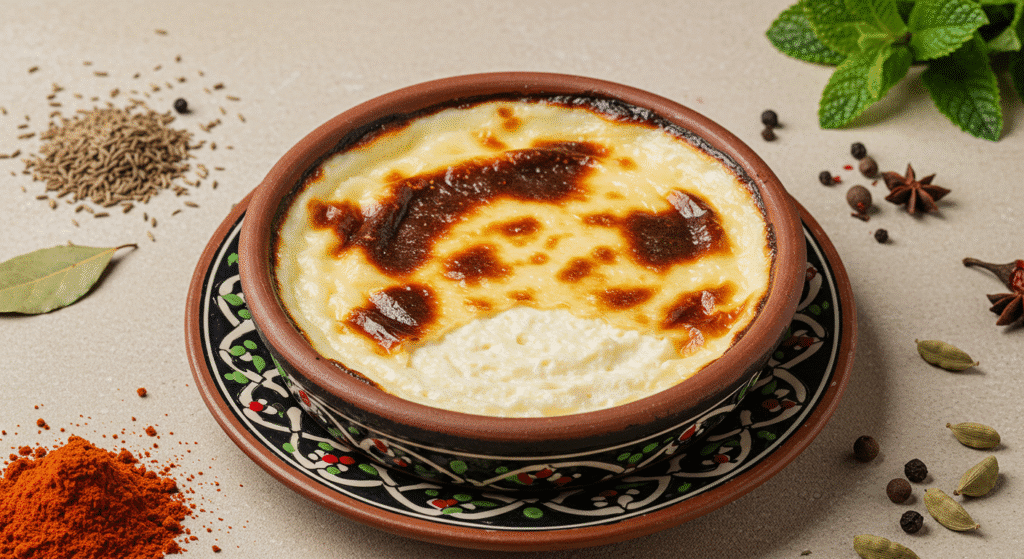
5. Sütlaç (Rice Pudding)
A comforting and simple dessert, sütlaç is made by simmering rice with milk and sugar, then baking it to form a light brown top. It’s often dusted with cinnamon and served cold, making it a perfect summer treat. (Turkish Food Desserts)
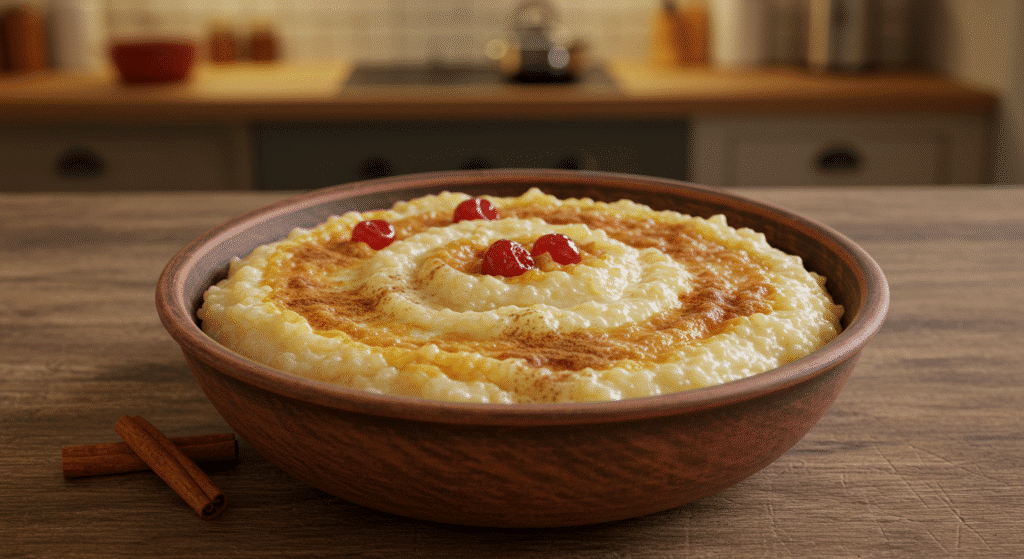
Ingredients
- 2 liters + 2 tablespoons of milk
- 75g rice
- 25 g wheat starch
- 200 g granulated white sugar
- 1 pinch of salt
- 120 ml heavy cream
6. Aşure (Noah’s Pudding)
One of the oldest desserts in the world, Aşure is rich in symbolism. It’s made with a mixture of grains like barley, dried fruits, nuts, and spices. It’s traditionally prepared during the month of Muharram and shared with neighbors and friends as a gesture of goodwill. (Turkish Food Desserts)
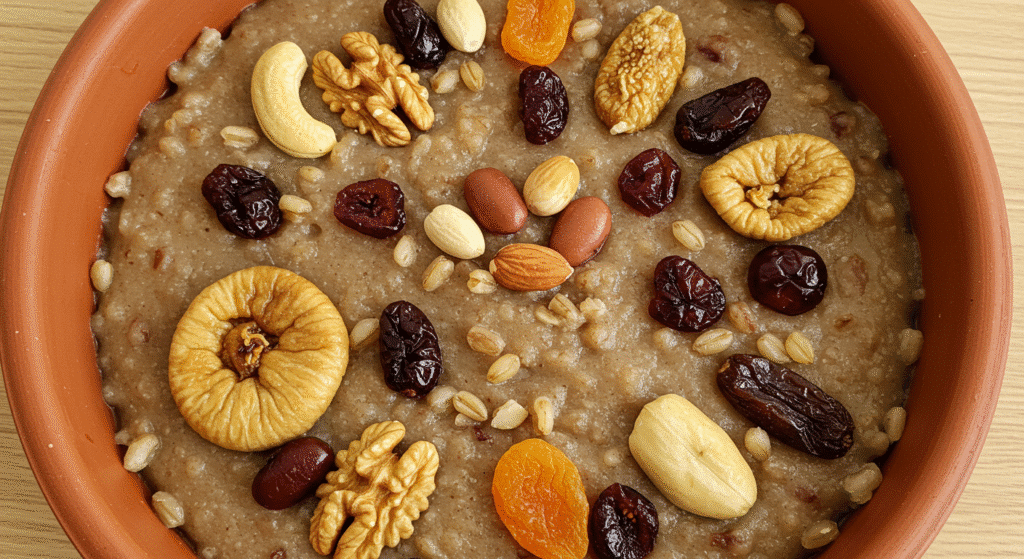
Ingredients
- 3 cups uncooked whole grain wheat, or barley
- 1 1/2 cups canned chickpeas, rinsed and drained
- 1 1/2 cups canned navy beans, rinsed and drained
- 1/4 cup uncooked rice
- 3 tablespoons dried currants
- 3 tablespoons pine nuts
- 8 half dried apricots, cut into chunks
- 8 dried figs, cut into chunks
- 3 cups sugar
- 2 cinnamon sticks
- 2 tablespoons orange zest, from 1 orange, optional
- 1 tablespoon lemon zest, from 1 lemon, optional
- 2 tablespoons rose water, optional
7. Revani
This semolina cake is soaked in lemon syrup and has a light, spongy texture. Revani is both zesty and sweet, and it’s frequently served during family gatherings and Ramadan dinners. (Turkish Food Desserts)
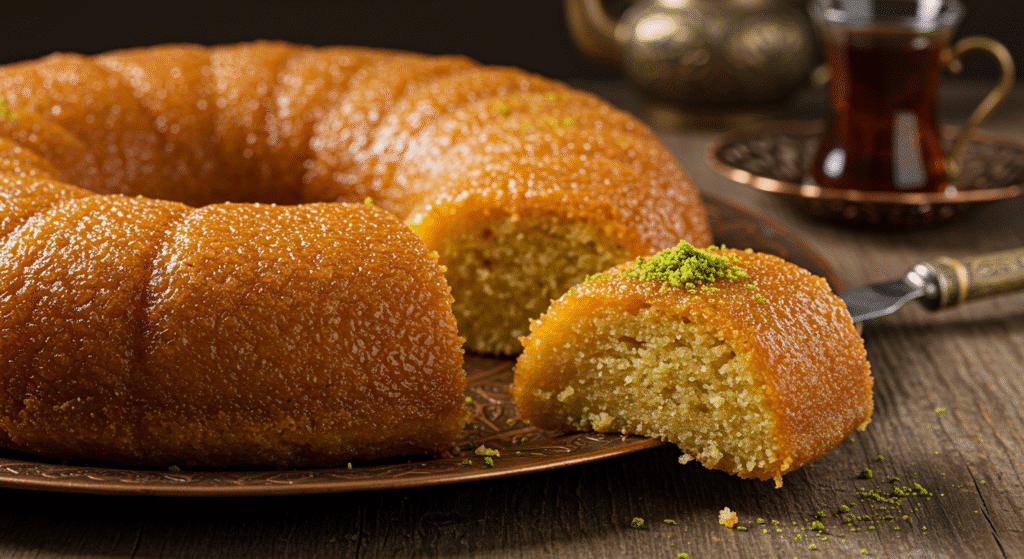
Ingredients
For the Syrup:
- 3 cups sugar
- 3 cups water
- 1/2 lemon, juiced
For the Cake:
- 3 large eggs
- 1/2 cup sugar
- 3/4 cup vegetable oil
- 1 lemon, zested
- 1 teaspoon vanilla
- 1 cup plain yogurt
- 3 tablespoons all-purpose flour
- 1 cup semolina
- 1/4 cup finely ground hazelnuts
- 1/2 teaspoon baking soda
- 2 teaspoons baking powder
- Coconut flakes, for garnish
- Ground nuts, for garnish
8. Şekerpare
Şekerpare translates to “a piece of sugar,” and it certainly lives up to the name. These semolina-based cookies are baked and then soaked in lemony syrup. They are soft, sweet, and pair perfectly with Turkish tea. (Turkish Food Desserts)
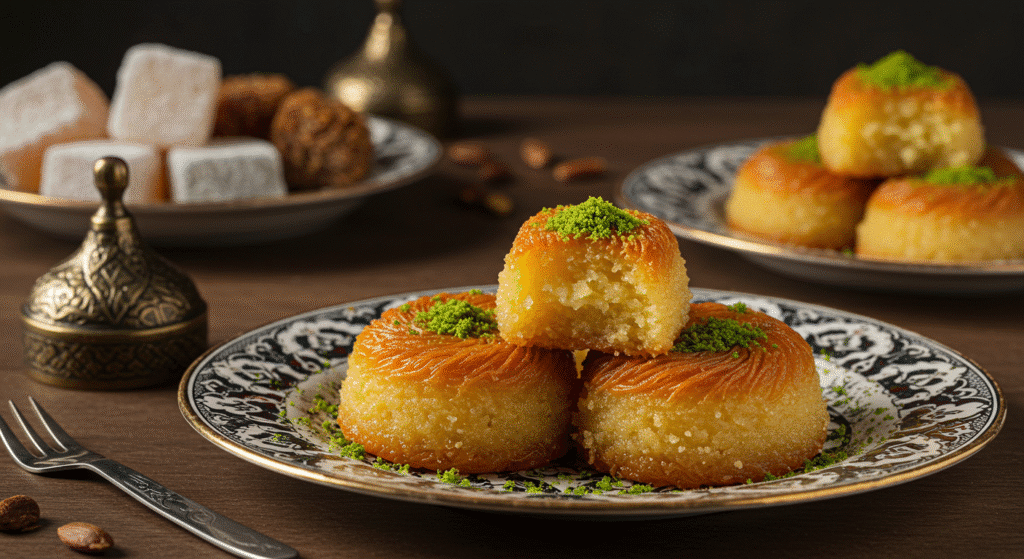
Ingredients
- 1 1/8 cups butter or margarine
- 2 1/4 cups flour
- 1 teaspoon baking powder
- 3 rounded tablespoons semolina
- 2/3 cup powdered sugar
- 1 rounded teaspoon European vanilla sugar
- 2 large eggs
- 4 cups water
- 2 1/4 cups sugar
- 1/2 fruit (2 3/8-inch diameter) lemon
- 25 to 30 almonds, or hazelnuts, for garnish
9. Halva
A dessert with several variations, Turkish halva can be made from tahini (sesame paste) or flour. It’s often eaten during religious events and family gatherings. The tahini version is particularly popular and has a nutty, crumbly texture. (Turkish Food Desserts)
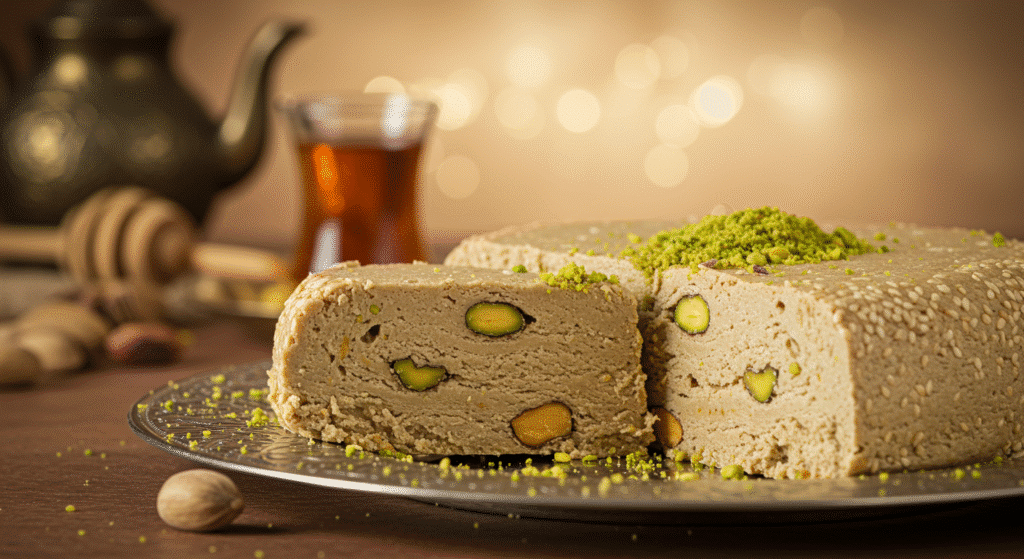
Ingredients 1x2x3x
- ▢1 ½ cups sugar
- ▢1/2 teaspoon cardamom
- ▢½ cup water
- ▢1 ⅔ cups tahini
- ▢1 teaspoon vanilla (See Note 1)
- ▢½ cup unsalted raw pistachios
10. Dondurma (Turkish Ice Cream)
Unlike regular ice cream, Dondurma is thick, stretchy, and slow to melt—thanks to salep (a flour made from orchid tubers). Vendors often perform fun tricks when serving it, making the experience as delightful as the taste. (Turkish Food Desserts)
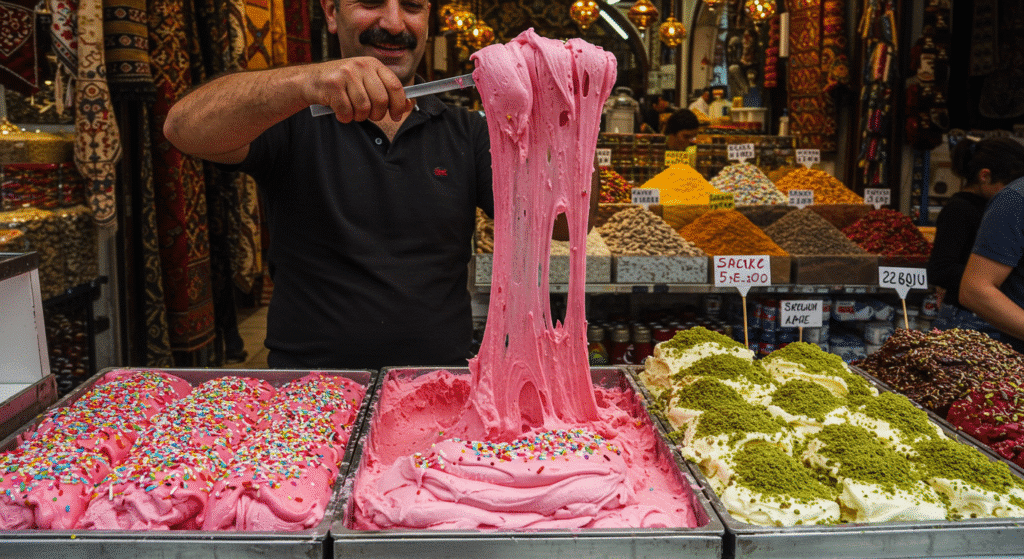
INGREDIENTS 1x2x3x
- 1 liter milk
- 1 and ½ cups sugar
- 1 tablespoon salep powder
INSTRUCTIONS
- Combine milk, sugar and salep powder in a large saucepan. Whisk well with a hand whisk.
- Put it over medium heat and cook it until sugar dissolves, stirring continuously.
- Reduce the heat to the lowest and keep cooking until it gets thicker in consistency. This might take 15-20 minutes.
- Transfer it into a freezer-safe container. Let it cool completely.
- Cover it with plastic wrap and put it into the freezer.
- Remove it from the freezer after 30 minutes and mix with a fork for 2-3 minutes. Make sure to fold in the icy bits on the edges of the container. Put it back into the freezer.
- Repeat this 5 or 6 times every 30 minutes. You will see how it gets stretchy in the end and it will get really hard to mix. This shows that your ice cream is almost ready.
- Keep it in the freezer until serving time, at least for 5 hours.
- Take it out 15 minutes before serving. Then you can easily scoop it and serve on the scone or on your desserts.
What Is the Signature Turkish Dessert?
Baklava holds the crown as Turkey’s signature dessert. Its layers of delicate filo dough, nuts, and sweet syrup represent the richness of Turkish culinary tradition. Although variations exist across the Middle East, the Turkish version—especially from the city of Gaziantep—is renowned worldwide.
What Is the National Sweet of Turkey?
While there’s no officially designated national sweet, Baklava is widely regarded as Turkey’s national dessert due to its deep cultural roots and historical significance. Another strong contender is Lokum (Turkish Delight), which has become a symbol of Turkish hospitality and tradition.
What Is Dessert in Turkish?
The Turkish word for dessert is “tatlı” (pronounced taht-luh). It broadly refers to anything sweet and is commonly used in everyday speech—whether you’re ordering at a restaurant or shopping at a bakery.
🍮 Final Thoughts on Turkish Food Desserts
Turkish food desserts offer a fascinating journey through textures, aromas, and centuries-old traditions. Whether you’re savoring a piece of pistachio-filled baklava or enjoying a creamy bowl of sütlaç, each dessert tells a story. Rich with cultural heritage and made with love, these sweets are not just food—they’re a celebration of Turkish life.

